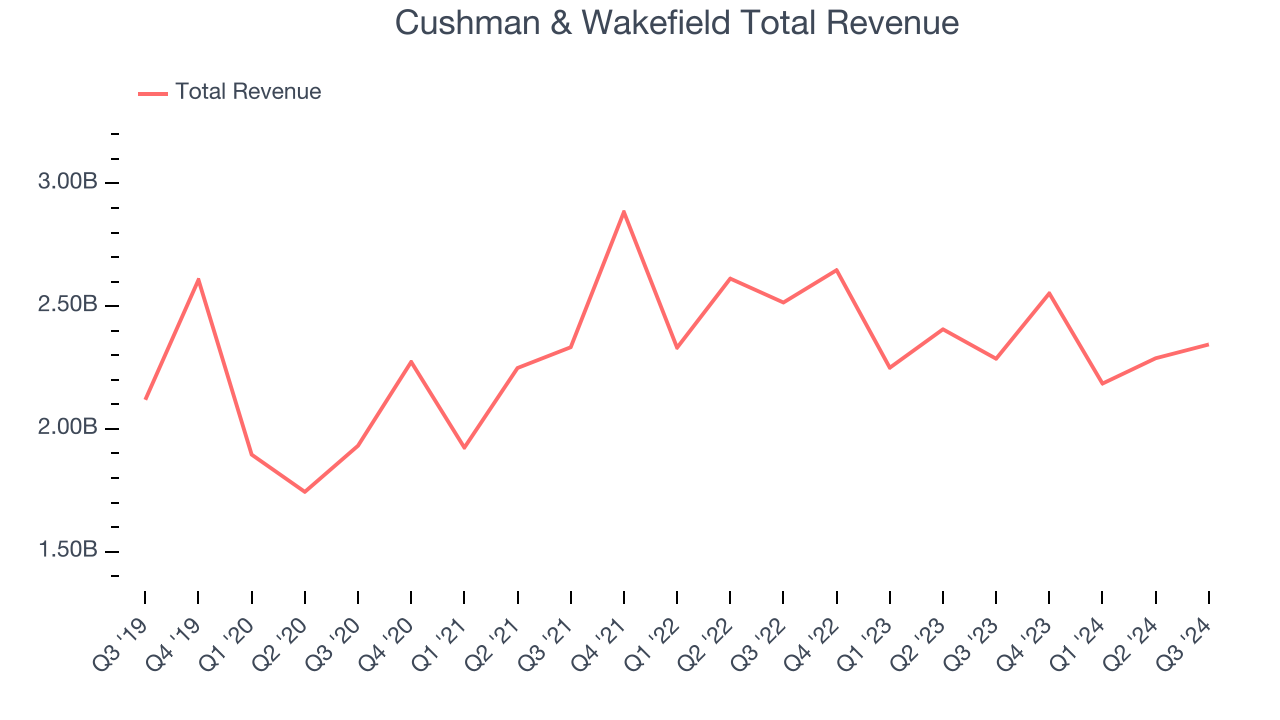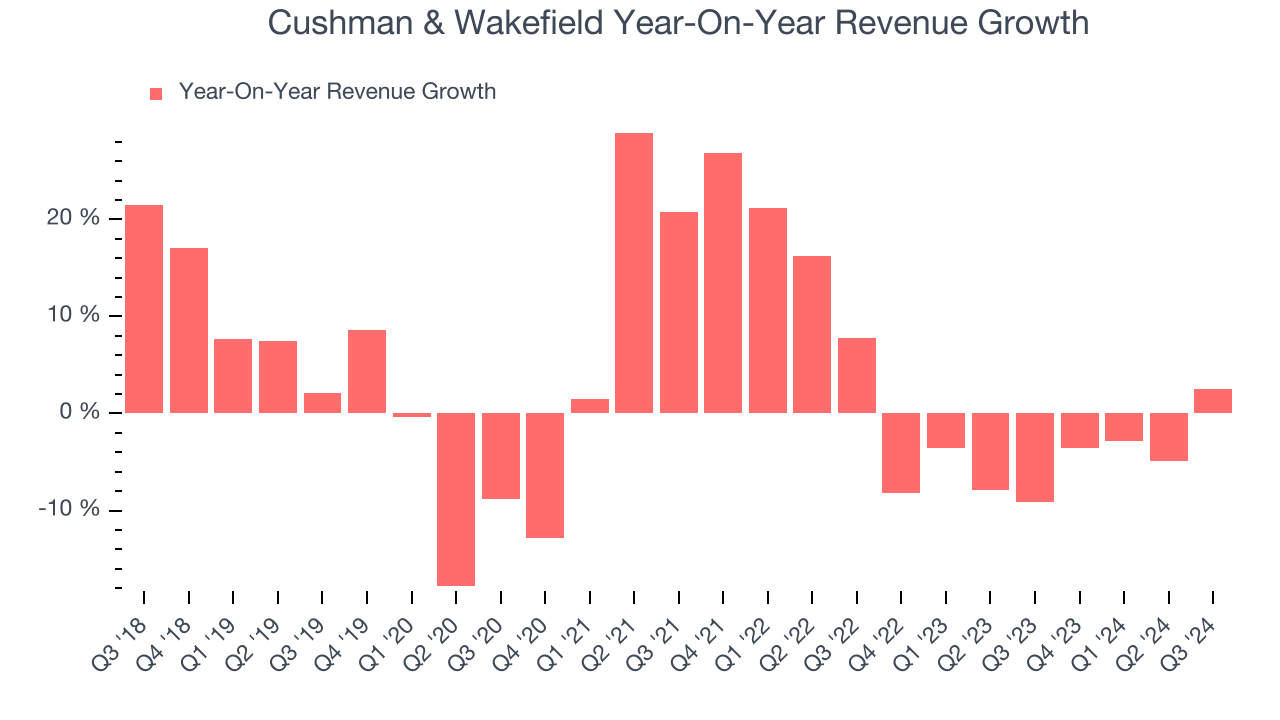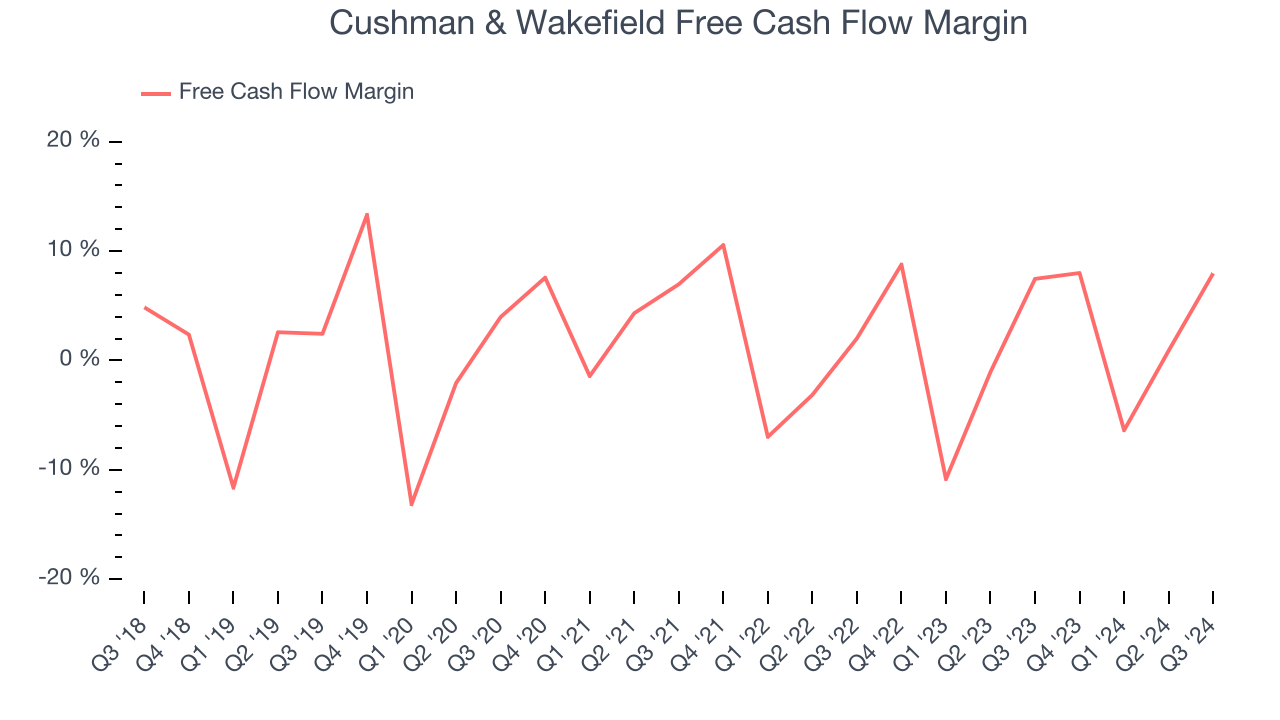
Real estate services firm Cushman & Wakefield (NYSE:CWK) fell short of the market’s revenue expectations in Q3 CY2024 as sales rose 2.5% year on year to $2.34 billion. Its non-GAAP profit of $0.23 per share was 11.2% above analysts’ consensus estimates.
Is now the time to buy Cushman & Wakefield? Find out by accessing our full research report, it’s free.
Cushman & Wakefield (CWK) Q3 CY2024 Highlights:
- Revenue: $2.34 billion vs analyst estimates of $2.39 billion (1.8% miss)
- Adjusted EPS: $0.23 vs analyst estimates of $0.21 (11.2% beat)
- EBITDA: $142.5 million vs analyst estimates of $142.8 million (small miss)
- Gross Margin (GAAP): 18.4%, in line with the same quarter last year
- Operating Margin: 3.2%, in line with the same quarter last year
- EBITDA Margin: 6.1%, in line with the same quarter last year
- Free Cash Flow Margin: 8%, similar to the same quarter last year
- Market Capitalization: $2.99 billion
Company Overview
With expertise in the commercial real estate sector, Cushman & Wakefield (NYSE:CWK) is a global Chicago-based real estate firm offering a comprehensive range of services to clients.
Real Estate Services
Technology has been a double-edged sword in real estate services. On the one hand, internet listings are effective at disseminating information far and wide, casting a wide net for buyers and sellers to increase the chances of transactions. On the other hand, digitization in the real estate market could potentially disintermediate key players like agents who use information asymmetries to their advantage.
Sales Growth
A company’s long-term performance can give signals about its business quality. Even a bad business can shine for one or two quarters, but a top-tier one grows for years. Over the last five years, Cushman & Wakefield grew its sales at a weak 1.9% compounded annual growth rate. This shows it failed to expand in any major way, a rough starting point for our analysis.

Long-term growth is the most important, but within consumer discretionary, product cycles are short and revenue can be hit-driven due to rapidly changing trends and consumer preferences. Cushman & Wakefield’s history shows it grew in the past but relinquished its gains over the last two years, as its revenue fell by 4.8% annually. 
We can dig further into the company’s revenue dynamics by analyzing its three most important segments: Management, Leasing, and Capital Markets, which are 36.9%, 21%, and 7.2% of revenue. Over the last two years, Cushman & Wakefield’s Management revenue (property management) averaged 1.1% year-on-year growth while its Leasing (sourcing tenants) and Capital Markets (financial advisory) revenues averaged declines of 5.4% and 29.4%.
This quarter, Cushman & Wakefield’s revenue grew 2.5% year on year to $2.34 billion, falling short of Wall Street’s estimates.
Looking ahead, sell-side analysts expect revenue to grow 5.5% over the next 12 months, an improvement versus the last two years. Although this projection indicates the market thinks its newer products and services will fuel better performance, it is still below the sector average.
Here at StockStory, we certainly understand the potential of thematic investing. Diverse winners from Microsoft (MSFT) to Alphabet (GOOG), Coca-Cola (KO) to Monster Beverage (MNST) could all have been identified as promising growth stories with a megatrend driving the growth. So, in that spirit, we’ve identified a relatively under-the-radar profitable growth stock benefitting from the rise of AI, available to you FREE via this link.
Cash Is King
If you’ve followed StockStory for a while, you know we emphasize free cash flow. Why, you ask? We believe that in the end, cash is king, and you can’t use accounting profits to pay the bills.
Cushman & Wakefield has shown poor cash profitability over the last two years, giving the company limited opportunities to return capital to shareholders. Its free cash flow margin averaged 2.1%, lousy for a consumer discretionary business.

Cushman & Wakefield’s free cash flow clocked in at $186.7 million in Q3, equivalent to a 8% margin. This cash profitability was in line with the comparable period last year and above its two-year average.
Key Takeaways from Cushman & Wakefield’s Q3 Results
It was good to see Cushman & Wakefield beat analysts’ EPS expectations this quarter. On the other hand, its Leasing revenue missed and its revenue fell short of Wall Street’s estimates. Overall, this was a mixed quarter. The stock traded up 3% to $13.53 immediately following the results.
Big picture, is Cushman & Wakefield a buy here and now? When making that decision, it’s important to consider its valuation, business qualities, as well as what has happened in the latest quarter. We cover that in our actionable full research report which you can read here, it’s free.
